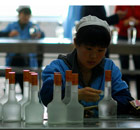-
-
China Daily E-paper
Liang Hongfu
Ode to health that melts in the mouth
By Hong Liang (China Daily)
Updated: 2010-02-02 07:04
 |
Large Medium Small |
House of Long Life is a small eatery on a side street in an old and modest district of Shanghai. From the outside, it looks just like any other neighborhood restaurant with cheap-looking aluminum-framed glass doors opening to a steamy room cramped with tables and chairs.
Before noon, the place was already packed with the lunch crowd, and a long line of customers waited patiently outside for their turn.
In the open kitchen, the chefs were busy placing small, white dumplings into bamboo steam baskets, which were piled on each other in stacks above boiling water in big woks. When done, the baskets, with the steaming hot dumplings inside, were delivered straight to the tables.
A customer was seen gingerly picking up a dumpling with his chopsticks and placing it in a spoon. He doused the dumpling with dark vinegar and carefully bit off a small piece of the thin skin of dough at the top. He waited a minute or so for the meat-ball and the juice inside to cool before putting the whole dumpling in his mouth. The ritual was repeated until all 10 dumplings in the basket were consumed.
These are not just any dumplings. They are xiaolongbao, which are to Shanghai people much like pizzas are to New Yorkers, or fish-and-chips to Londoners.
The culinary culture in Shanghai has blossomed in the past several years to include the cuisines of many different countries. The collective influence of these foreign cuisines has, in turn, touched off a revolution in the city's diet, resulting in a loss of many traditional dishes characterized by "thick oil and dark sauce". But xiaolongbao has remained pretty much unchanged throughout the centuries.
A well-known Shanghai food critic once declared that xiaolongbao is everybody's comfort food. Shanghai people eat the dumpling anytime they wish, breakfast, lunch or dinner. I know some Shanghai friends who insist on eating at least one or two dumplings even after a big feast to, as they say, make the meal complete.
Unsurprisingly, there is no shortage of eateries serving xiaolongbao. They range from Chinese restaurants in five-star hotels to specialty eateries like House of Long Life to the many roadside food stalls that steam the dumplings in giant bamboo baskets of more than 2 feet in diameter.
There is a never-ending debate in print media and on the Internet among food critics and aficionados about who in Shanghai serves the best and most authentic xiaolongbao. But almost all agree that the perfect xiaolongbao is defined by the thinness and consistency of its skin and the subtle taste of the enclosed soup and meat, characterized by a taint of sweetness that must be done right.
Legend has it that the widely accepted standard of perfection was established more than a century ago by dumpling masters in Nan Xiang, a small county that has now been incorporated into the Shanghai municipality. Their art, food critics say, has been successfully replicated at the xiaolongbao restaurant named after the county in the tourist district at the City God Temple in Shanghai.
Others insist on taking the hour-long ride to Nan Xiang itself for a taste of the real stuff. There are those who contend that better xiaolongbao can be available in this or that hole-in-the-wall eatery tucked away in one of the nameless alleyways and side roads.
Shanghai aficionados scoff at the xiaolinbao of the neighboring cities. They are either too sweet, like those in Wuxi in Jiangsu province, or too crude as those in Ningbo in Zhejiang province.
Now, Shanghai has a perfect opportunity, 2010 World Expo, to promote its own brand of superior xiaolongbao to people from around the country and overseas. A McDonald's- or KFC-style xiaolongbao restaurant chain doesn't seem so far-fetched.
E-mail: jamesleung@chinadaily.com.cn
(China Daily 02/02/2010 page9)









